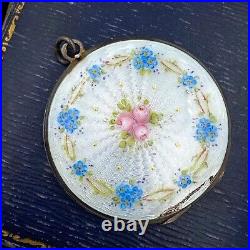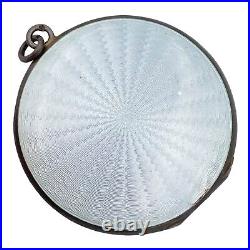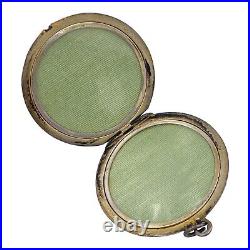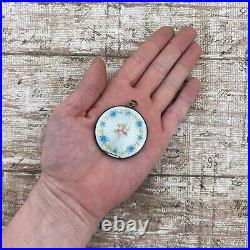




We have similar Locket and Art Nouveau items, which would pair nicely with this piece, for sale this week. Listing Description by: Cameron J. Main Stone Measurements/Color. Accent Stone Measurements/Color. Closure/Clasp Type: Jump ring bale. Pendant Type: Drop pendant. Handmade during the Art Nouveau era. The pendant features guilloche enamel on the front and back. The front of the pendant is hand painted with floral motifs. The pendant opens and has room for two pictures inside. Complete with a jump ring bale for secure wear on antique chains and necklaces. Damage: Age appropriate wear. Tarnish on the sterling silver gives this piece an antique quality which we believe is quite lovely. The glass along the bottom of the locket near the hinge is cracked slightly. This does not affect wear. The price has been reduced to reflect this. This listing is for the item only. This was true due to the gorgeous designs that emerged from this period. This era drew inspiration from the beauty of women and the natural world, and the resulting pieces were often large and elegant. Because the period emphasized the importance of the design over the materials used to create it, enamel was a common material used in Art Nouveau jewelry. The Art Nouveau period occurred before the start of the first World War, when mass manufacturing took over the production of many products, including some jewelry. The Guilloche method of enameling starts with an etched metal base, usually a highly intricate and repeating geometrical pattern, that is then finished with a translucent to semi-translucent enamel to highlight the carved details underneath to show through and add a metallic luster to the piece. Originally Guilloche bases were hand carved, but that changed during the 18th century with the invention of turn engine machinery that could carve metal patterns. In modern times, the definition of Guilloche became a blanket term for various methods of surface alteration; engraved, printed, or otherwise created. It also came to incorporate carvings which were not necessarily repetitive or geometric. A famous example of this style was explored by Peter Carl Faberge on his eggs during the 19th century. Cartier, Boucheron, and Tiffany all followed suit, creating stunning pieces which are still in high demand today. Enameling originally dates all the way back to the ancient Persians of Meenakari. The technique involves bonding powdered glass to a base, usually gold, by firing (heating and melting the glass onto the metal). The glass hardens to form a layer of pigment over the metal. Enamel is made of colored powdered glass or may include clear powdered glass that is mixed with colorful metallic pigments. It was used by the ancient Egyptians, Greeks, and Celts; and later the Chinese and Georgians. It resurged in popularity in the 20th century. It is primarily used on decorative art or jewelry, usually small in size. Besides jewelry, enamel can also be applied to glass, ceramic, stone, and various other materials. This item is in the category “Jewelry & Watches\Vintage & Antique Jewelry\Necklaces & Pendants”. The seller is “abeautifultimeco” and is located in this country: US. This item can be shipped worldwide.
- Brand: Unbranded
- Pendant Shape: Round
- Type: Pendant
- Metal Purity: .925
- Era: Art Nouveau (1895-1910)
- Pendant/Locket Type: Photo
- Style: Pendant
- Material: Glass
- Metal: Sterling Silver
- Country/Region of Manufacture: Unknown
- Modified Item: No
- Handmade: Yes
